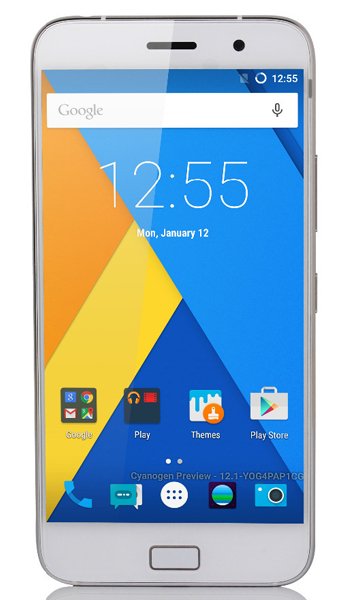Lenovo Zuk Z1 vs Xiaomi Mi Note Comparison and Differences
Smartphone 1

Lenovo Zuk Z1
Smartphone 2

Xiaomi Mi Note
Smartphone 3
Lenovo Zuk Z1 or Xiaomi Mi Note Specs Comparison
or
 Common specs
Common specs
| Brand and model | Lenovo Zuk Z1 | Xiaomi Mi Note | |
| Rating | (+0) | (+0) | |
| Release date | 2015, August | 2015, January | |
| Dimensions (HxWxD) | 155.7 x 77.3 x 8.9 mm | 6.13 x 6.13 x 3.04 in | 155.1 x 77.6 x 7 mm | 6.11 x 6.11 x 3.06 in | |
| Weight | 175 g | 6.17 oz | 161 g | 5.68 oz | |
| Body Build | Front/back glass (Gorilla Glass 3), aluminum frame | ||
| Case | buy from Amazon | buy from Amazon | |
| Colors | White, Dark Gray | Black, White | |
| Battery | 4100 mAh, Non-removable Li-Po | 3000 mAh, Non-removable Li-Ion | |
| Battery life |
Stand by time - Up to 526 h (3G) Talking time - Up to 38 h (3G) |
||
| Approximate price | 320 EUR | 190 EUR | |
| Check price | from Amazon | from Amazon |
 Screen
Screen
| Technology | IPS LCD | IPS LCD | |
| Touchscreen | capacitive touchscreen | capacitive touchscreen | |
| Display colors | 16M | 16M | |
| Screen size | 5.5" in | 5.7" in | |
| Screen area | 83.4 cm2 | 89.6 cm2 | |
| Screen format | 16:9 (height:width) | 16:9 (height:width) | |
| Screen to body ratio | 69.3% | 74.4% | |
| Screen resolution | 1080 x 1920 px | 1080 x 1920 px | |
| Screen PPI /points per inch/ | 401 PPI | 386 PPI | |
| Screen protection | Corning Gorilla Glass 3 | ||
| Other specs | - CyanogenMod 12.1 | ||
| Screen protector | buy from Amazon | buy from Amazon |
 Camera and Video
Camera and Video
| Rear camera, main | 13 MP, Single | 13 MP, Single | |
| Camera specs | -13 MP, f/2.2, 1.12µm, OIS, AF | -13 MP, OIS, AF, f/2.0 | |
| Functions | Dual-LED flash, panorama | Dual-LED dual-tone flash, HDR, panorama | |
| Video | 1080p@30fps, 1080p@60fps | 2160p@30fps, 1080p@30fps | |
| Front camera, selfie | 8 MP, Single | 4 MP, Single | |
| Specifications | 8 MP, f/2.2 | 4 MP, f/2.0, 1/3'', 2µm | |
| Video | 1080p@30fps | 1080p@30fps |
 Performance
Performance
| Operating system - OS | Android 5.1.1 (Lollipop), upgradable to 6.0 (Marshmallow) | Android 4.4.4 (KitKat), upgradable to 6.0 (Marshmallow) | |
| Chipset | - Qualcomm MSM8974AC Snapdragon 801 (28 nm) | - Qualcomm MSM8974AC Snapdragon 801 (28 nm) | |
| CPU | - Quad-core 2.5 GHz Krait 400 | - Quad-core 2.5 GHz Krait 400 | |
| GPU | Adreno 330 | Adreno 330 | |
| External memory | No | No | |
| Internal memory | 64 GB, 3 GB RAM | 16/64 GB, 3 GB RAM |
 Benchmark
Benchmark
| GeekBench 5 Single Core | 158 | 151 | |
| GeekBench 5 Multi-Core | 503 | 467 | |
| GeekBench 4 Single Core | 1025 | 928 | |
| GeekBench 4 Multi-Core | 2700 | 2128 | |
| GeekBench 4 RenderScript | 2361 | 2038 |
 Communication and Connectivity
Communication and Connectivity
| SIM card | Dual SIM (Nano-SIM, dual stand-by) | Dual SIM (Micro-SIM/Nano-SIM, dual stand-by) | |
| Network | GSM / CDMA / HSPA / LTE | GSM / HSPA / LTE | |
| Bands | -2G - GSM 850 / 900 / 1800 / 1900 - SIM 1 & SIM 2 CDMA 800 -3G - HSDPA 850 / 900 / 1900 / 2100 TD-SCDMA -4G - LTE band 1(2100), 3(1800), 7(2600), 38(2600), 39(1900), 40(2300), 41(2500) |
-2G - GSM 850 / 900 / 1800 / 1900 - SIM 1 & SIM 2 -3G - HSDPA 850 / 1900 / 2100 TD-SCDMA -4G - LTE band 3(1800), 7(2600), 38(2600), 39(1900), 40(2300), 41(2500) |
|
| Speed | HSPA 42.2/5.76 Mbps, LTE Cat4 150/50 Mbps | HSPA, LTE Cat4 150/50 Mbps | |
| GPRS | Yes | Yes | |
| Edge | Yes | Yes | |
| Wi-Fi | Wi-Fi 802.11 a/b/g/n/ac, dual-band, hotspot | Wi-Fi 802.11 a/b/g/n/ac, dual-band, WiFi Direct, hotspot | |
| GPS | Yes, with A-GPS, GLONASS | Yes, with A-GPS, GLONASS, BDS | |
| NFC | |||
| USB | 3.0, Type-C 1.0 reversible connector | microUSB 2.0, USB Host | |
| Bluetooth | 4.1, A2DP, LE | 4.1, A2DP, LE |
 Music and Audio
Music and Audio
| Radio | No | No | |
| Headphone jack | Yes | Yes | |
| Others | - Active noise cancellation with dedicated mic | - 24-bit/192kHz audio -Active noise cancellation with dedicated mic |
 Other features
Other features
| Sensors | - Fingerprint (front-mounted), accelerometer, gyro, proximity, compass | - Accelerometer, gyro, proximity, compass, barometer | |
| Other extras |
- Fast battery charging |
- Fast battery charging (Quick Charge 2.0) |
Reviews and Opinions on Lenovo Zuk Z1 and Xiaomi Mi Note
If you had to recommend one of these phones to a friend, which one would it be and why? Share your arguments using the Add Opinion button!
